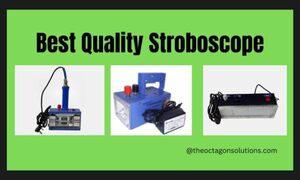Blog Information
- Posted By : octagon solutions
- Posted On : Aug 10, 2023
- Views : 218
- Category : General
- Description : A stroboscope is an optical instrument that emits short bursts of intense light at specific frequencies, synchronized with the periodic motion of objects. This creates the illusion of slowing down or freezing motion, allowing for detailed observation and analysis of high-speed movements.
Overview
The flexo and rotogravure printing industry demands precision, accuracy, and impeccable print quality. To achieve these standards, having the right tools is crucial. Stroboscopes, with their ability to provide visual insights into high-speed processes, play a pivotal role in ensuring optimal performance and quality control. In this article, we will explore the best quality stroboscopes tailored for the flexo and rotogravure printing industry.
Best Quality Features:
- High-Intensity Illumination: Intense bursts of light for clear visualization of fast-moving printing components.
- Adjustable Flash Frequency: Precise control over flash frequency to match machinery motion.
- Robust Construction: Designed to withstand industrial environments, ensuring longevity.
Application in the Printing Industry:
- Continuous monitoring of printing cylinders, rollers, and other components.
- Alignment and synchronization of printing elements for uniform and high-quality prints.
Best Quality Features:
- Mobility and Convenience: Handheld and portable for on-site inspections and troubleshooting.
- Adjustable Parameters: Control over flash frequency and intensity for versatile applications.
Application in Printing Industry:
- Quick on-site inspections of printing processes for immediate adjustments.
- Detecting irregularities or misalignments in real-time to maintain quality.
Best Quality Features:
- Advanced Controls: Microprocessors and digital displays for precise adjustments.
- Multiple Modes: Different operating modes for various inspection needs.
Application in Printing Industry:
- Fine-tuning synchronization and alignment of printing elements.
- In-depth analysis and troubleshooting of complex printing processes.
4. Tube Stroboscope (U-Tube Stroboscope):
Best Quality Features:
- Enhanced Coverage: U-shaped flash tubes for wider illumination of printing components.
- High-Intensity Output: Intense light bursts for clear visibility.
Application in Printing Industry:
- Inspection of larger printing cylinders and rollers for uniform prints.
- Alignment of multiple components in multi-color printing processes.
5. Hand Model Stroboscope (Handheld Stroboscope):
Best Quality Features:
- Compact Design: Easy-to-operate handheld stroboscope for versatile use.
- LED Light Source: Energy-efficient and long-lasting illumination.
Application in Printing Industry:
- Visual analysis of fast-moving components during printing operations.
- Immediate identification of issues and adjustments for consistent print quality.
Selecting the Right Stroboscope:
When choosing a stroboscope for the flexo and rotogravure printing industry, consider factors such as the specific printing processes, the size of components, and the level of detail required for inspections. Opt for stroboscopes with adjustable parameters, high-intensity illumination, and durability to withstand the demands of the printing environment. Additionally, digital stroboscopes can provide advanced control and analysis capabilities, enhancing the efficiency of quality control processes.
In conclusion
investing in the best quality stroboscopes tailored for the flexo and rotogravure printing industry is a crucial step in achieving optimal print quality, precision, and operational efficiency. These stroboscope empower printing professionals to maintain synchronization, detect issues promptly, and ensure the consistency of prints, ultimately contributing to the success of the printing business.
